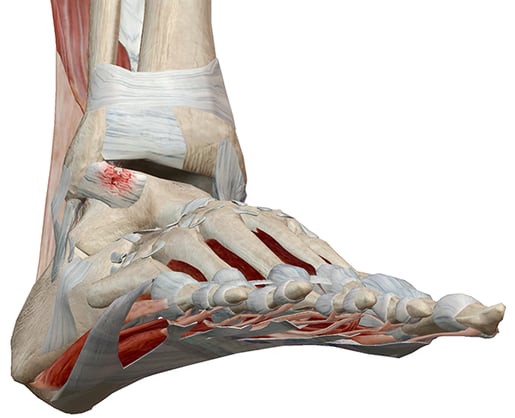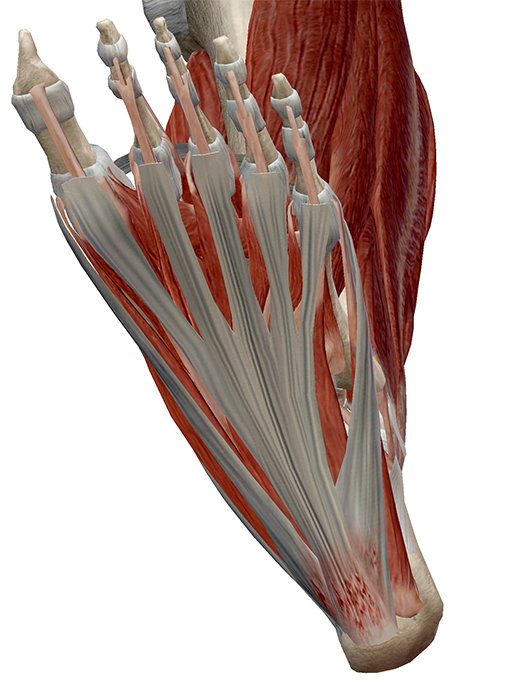Posted on 10/12/18 by Madison Oppenheim
You rely on your legs and feet all day to get you where you need to be, support you while you wait in line at Disneyland, and help you keep your balance as you bend over to tie your shoe!
Unfortunately, the lower legs and feet are among the most commonly injured body parts, particularly for those who engage in high-demand sports that require sudden directional changes. Let's take a look at four common pathologies that can affect this region.
Want to learn more about sports injuries? Check out our free "Sports Injuries 101" eBook!

Partially torn ACL. Image from Muscle Premium.
Ruh roh! One minute you're dribbling a soccer ball down the turf, faking left, then right, then BAM! A sharp, popping noise! Next thing you know, you're on the ground in the fetal position.
A knee sprain can occur when a jump or sharp pivot twists or hyperextends the joint. The force can damage or tear one or more knee ligaments, resulting in excruciating pain and instability. Partial or complete tearing of the anterior cruciate ligament (ACL) is super common in knee sprains. The ACL frequently ruptures during contact sports—football, soccer (as mentioned above), basketball, and gymnastics, to name a few—which require the kind of jump or rapid changes of direction that can exert excessive force on the knee, leading to injury.

Posterior horn tear. Image from Muscle Premium.
Inside each knee there are these two rubbery discs that act as a cushion between the bones. This C-shaped tissue, called the meniscus, keeps your knees balanced. Twisting or rotating at the knee joint can tear the meniscus if the action is forceful enough, or if the cartilage has degenerated due to age. Common symptoms include pain and swelling, as well as general instability of the joint. The posterior horn of the meniscus (aka, the back part) is the most common location for a tear.

Partially torn ATFL. Image from Muscle Premium.
Most people have "sprained" their ankle at least once in their life; you trip or step funny and all of the sudden it feels like your foot is detached from your leg. You RICE it (rest, ice, compress, elevate) and pretty soon it's back to normal. But what is a sprain, really?
An ankle sprain occurs when the foot turns, twists, or rolls, and one of the ankle ligaments is stretched beyond its normal range. This can damage or tear the ligament's connective tissue. Symptoms include ranges of pain, swelling, and joint instability. The most commonly injured ankle ligament is the anterior talofibular ligament (ATFL).

Plantar fascia with microtears. Image from Muscle Premium.
Your feet are powerful, durable, and can take a punch—so to speak (please do not actually try to punch your foot, that would be ridiculous). Your feet are also very delicate; they are made up of numerous muscles, ligaments, bones, and tendons, all of which can easily be damaged. Your plantar fascia is a thick band of connective tissue that extends from the heel to the digits on the plantar surface of the foot. This fascia gives your feet the support they need to twirl, skip, run, and perform every other motion your heart (feet?) desires.
Plantar fasciitis presents as pain in the heel or arch of the foot. Running, dancing, and other activities that repeatedly pound the feet on hard surfaces or put too much tension on the plantar fascia can cause microtears in the tissue, leading to irritation and inflammation.
All the images from this blog are taken from Muscle Premium 2018, a 3D visual and interactive platform and app. It was created by Visible Body for physical therapists, chiropractors, sports medicine practitioners, and orthopedic specialist. Muscle Premium is available for consumers on multiple devices, and as a web and mobile access site license for schools, universities, and businesses.
Looking for more info on plantar fasciitis? Look no further than this blog post written by fellow Visible Body author, Marian!
Be sure to subscribe to the Visible Body Blog for more anatomy awesomeness!
Are you a professor (or know someone who is)? We have awesome visuals and resources for your anatomy and physiology course! Learn more here.
Additional Sources:
When you select "Subscribe" you will start receiving our email newsletter. Use the links at the bottom of any email to manage the type of emails you receive or to unsubscribe. See our privacy policy for additional details.
©2026 Visible Body, a division of Cengage Learning